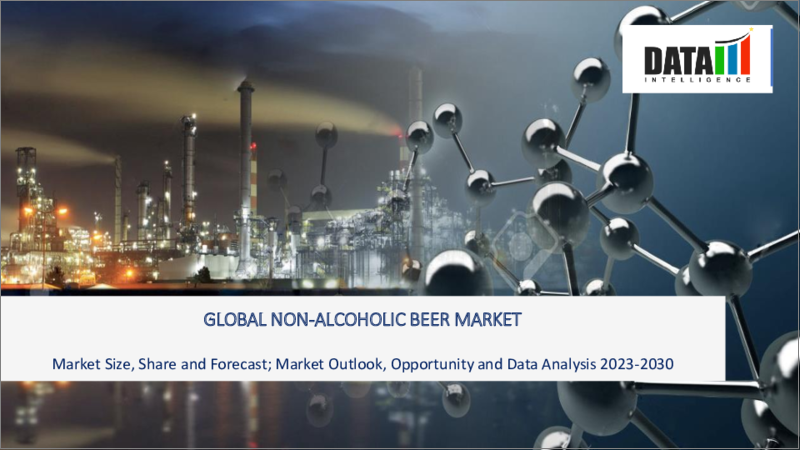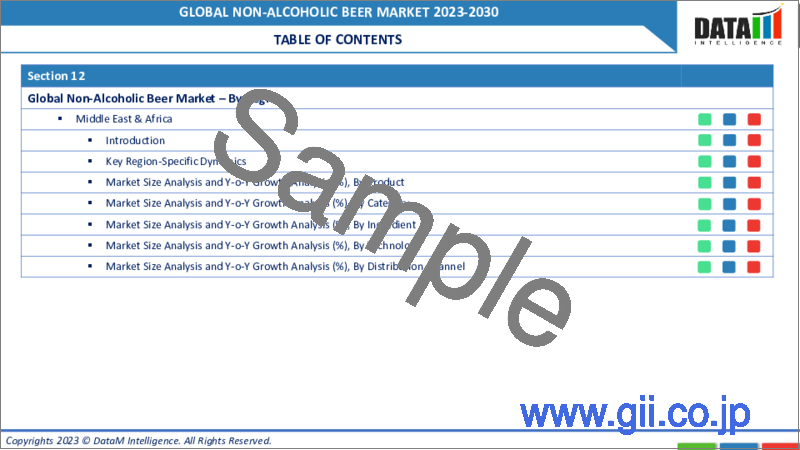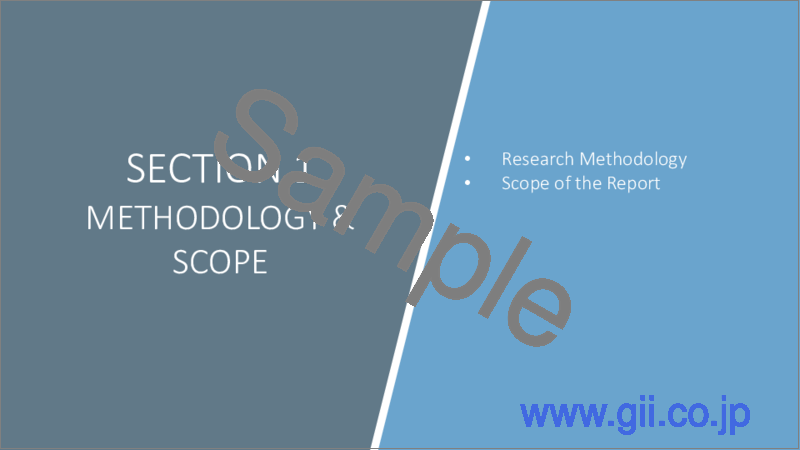|
|
市場調査レポート
商品コード
1319175
ノンアルコールビールの世界市場-2023年~2030年Global Non-Alcoholic Beer Market - 2023-2030 |
||||||
カスタマイズ可能
適宜更新あり
|
|||||||
| ノンアルコールビールの世界市場-2023年~2030年 |
|
出版日: 2023年07月31日
発行: DataM Intelligence
ページ情報: 英文 190 Pages
納期: 即日から翌営業日
|
- 全表示
- 概要
- 目次
市場概要
世界のノンアルコールビール市場は、2022年に202億米ドルに達し、2030年には287億米ドルに達し、予測期間2023-2030年のCAGRは4.5%で成長すると予測されています。人々の健康志向の高まりは、アルコール飲料よりもノンアルコールビール市場の巨大な拡大につながります。
販売チャネルの拡大は、市場拡大の有利な機会を生み出します。主要企業はM&A、提携、合弁事業を通じて事業の多角化を進めています。アルコールを含まないクラフトビールのイントロダクションが、市場の成長をさらに後押ししています。例えば、オレゴン州ポートランドのノンアルコール・クラフトビール会社Kit NA Brewingは、2023年に初のバラエティパックを発売しました。
ノンアルコールビールの利点に対する認識の高まりが、ノンアルコールビール市場の成長を支えました。アップストリーム・ブルーイング・カンパニーの記事によると、アルコールフリー・ビールは心臓血管の健康を改善し、骨密度を高め、骨粗鬆症のリスクを低減し、母乳分泌を促進します。これらの要因がノンアルコールビール市場の成長を促進しています。
市場力学
植物由来の製品に関連する健康上の利点が市場成長を牽引しています
アルコール飲料は健康に悪影響を及ぼします。脳、肝臓、膵臓、消化器系を痛める。米国国立がん研究所によると、飲酒が数種類のがんを引き起こす可能性があるという確かな科学的コンセンサスがあります。このような悪影響があるため、人々は同じような感覚で飲めるが、健康上の利点がある代替品を探しています。
ノンアルコールビールは、その健康上の利点のために絶大な拡大を得ています。ノンアルコールビールは、乳房の乳汁分泌を促進します。ノンアルコールビールは熟睡感をもたらし、不安やストレスを軽減します。さらに、心血管疾患のリスクを低下させるのに役立ちます。また、選手に余分なエネルギーを供給するため、スポーツ栄養にも含まれています。
ノンアルコールビール市場の成長を牽引すると推定される新発売とイノベーション
主要な市場プレーヤーは、世界のカバレッジを拡大するために強力な戦略を採用しています。消費者のパターンの変化を考慮し、消費者のニーズに応えるために製品ポートフォリオに新しいバリエーションを導入しています。多くの企業が、味と品質に付加価値をつけたフルーツ入りノンアルコールビールを発売しています。例えば、クールバーグ・ストロベリーは、イチゴと麦芽のファンタスティックな味わいを黄金色のビールに詰め込んだノンアルコールビールです。
革新的な技術により、ブドウやリンゴなど様々な原材料が加工されています。さらに、製品ポートフォリオに0.5%のノンアルコールビールを含めることで、アルコール消費者の嗜好がノンアルコールビールにシフトしています。そのため、消費者を惹きつける魅力が増し、ノンアルコールビール市場の成長を牽引しています。
ノンアルコール飲料ルに伴う健康上の利点が市場成長を牽引しています
アルコール飲料は健康に悪影響を及ぼします。脳、肝臓、膵臓、消化器系を痛める。米国国立がん研究所によると、飲酒が数種類のがんを引き起こすという確かな科学的根拠があります。このような弊害があるため、人々は同じような感覚で飲めるが健康にも良い代替品を探しています。
ノンアルコールビールには、必須ビタミン、ミネラル、食物繊維、抗酸化物質が豊富に含まれています。ノンアルコールビールは、乳房の乳汁分泌を促進します。熟睡をもたらし、不安やストレスを軽減します。さらに、心血管疾患のリスクを下げるのにも役立ちます。また、選手に余分なエネルギーを供給するため、スポーツ栄養にも含まれています。
高い製造・小売コストがノンアルコールビール市場の成長を抑制しています
ノンアルコールビールはアルコール飲料に比べて高価です。この要因が市場成長の抑制要因となっています。ノンアルコールビールは新興市場です。新しくてユニークな製品を生み出すために、常に多くの研究開発が行われています。eコマースサイト「Drizly」によると、ノンアルコール・スピリッツの平均コストは、アルコール入りスピリッツより若干高いです。これは、ノンアルコール・スピリッツには、伝統的な蒸留器が新しい製法を研究開発する必要があることが多いためです。
ノンアルコールビールの原料は、通常のビールの原料よりも高価であることが多いです。ビールからアルコールを除去するには、追加の工程と設備が必要で、これが製造コストを押し上げます。高いマーケティングと流通コスト、特殊なパッケージング、少量の生産、継続的な研究開発が、ノンアルコールビールの高価格の一因となっています。
COVID-19影響分析
COVID-19分析には、COVID前シナリオ、COVIDシナリオ、COVID後シナリオに加え、価格力学(COVID前シナリオと比較したパンデミック中およびパンデミック後の価格変動を含む)、需給スペクトラム(取引制限、封鎖、およびその後の問題による需給の変化)、政府の取り組み(政府機関による市場、セクター、業界を活性化させる取り組み)、メーカーの戦略的取り組み(COVID問題を緩和するためにメーカーが行ったことをここで取り上げる)が含まれます。
目次
第1章 調査手法と調査範囲
第2章 市場の定義と概要
第3章 エグゼクティブサマリー
第4章 市場力学
- 市場への影響要因
- 促進要因
- 抑制要因
- 機会
- 影響分析
第5章 産業分析
- ポーターのファイブフォース分析
- サプライチェーン分析
- 価格分析
- 規制分析
第6章 COVID-19分析
第7章 タイプ別
- アルコールフリービール
- 脱アルコールビール
- 低アルコールビール
第8章 技術別
- 制限発酵
- 脱アルコール
- その他
第9章 原料別
- 麦芽
- ホップ
- 酵母
- その他
第10章 流通チャネル別
- スーパーマーケットおよびハイパーマーケット
- 専門店
- eコマース
- その他
第11章 地域別
- 北米
- 米国
- カナダ
- メキシコ
- 欧州
- ドイツ
- 英国
- フランス
- イタリア
- スペイン
- その他欧州
- 南米
- ブラジル
- アルゼンチン
- その他南米
- アジア太平洋
- 中国
- インド
- 日本
- オーストラリア
- その他アジア太平洋地域
- 中東・アフリカ
第12章 競合情勢
- 競合シナリオ
- 市況/シェア分析
- M&A分析
第13章 企業プロファイル
- Anheuser-Busch InBer
- 会社概要
- 製品ポートフォリオと説明
- 財務概要
- 主な発展
- Bernard Brewery
- Behnoush Iran
- Suntory Beer
- Weihenstephan
- Coors Brewing Company
- Erdinger Weibbrau
- Big Drop Brewing Co
- Heineken N.V.
- Athletic Brewing Company
第14章 付録
Market Overview
The Global Non-Alcoholic Beer Market reached US$ 20.2 billion in 2022 and is expected to reach US$ 28.7 billion by 2030 and grow with a CAGR of 4.5% during the forecast period 2023-2030. The growing health consciousness among people leads to the immense expansion of the non-alcoholic beer market over alcoholic beverages.
Expansion of sales channels generates lucrative opportunities for market expansion. Key companies are diversifying their businesses through mergers & acquisitions, collaborations, and joint ventures. The introduction of craft beers, which have no alcohol content, has further boosted the market growth. For instance, in 2023, Kit NA Brewing, a Portland, Oregon,n non-alcoholic craft beer company, launched its first-ever variety pack.
The growing awareness of the benefits of alcohol-free beverages supported the growth of the non-alcoholic beer market. According to an article by Upstream Brewing Company, alcohol-free beer improves cardiovascular health, increases bone mineral density, reduces the risk of osteoporosis, and stimulates breast milk production. These factors are driving the non-alcoholic beer market growth.
Market Dynamics
Health Advantages Associated With Plant-Based Products is Driving the Market Growth.
Alcoholic drinks have adverse effects on health. They hurt the brain, liver, pancreas, and digestive system. According to the National Cancer Institute, there is a solid scientific consensus that alcohol drinking can cause several types of cancer. These ill effects are causing people to look for an alternative that gives the same feel but with health benefits.
Non-alcoholic beer is gaining immense expansion cause of its health advantages. Non-alcoholic beer helps stimulate the milk production of breasts. It reduces anxiety and stress by providing sound sleep. In addition, it helps in lowering the risk of cardiovascular diseases. It is also included in sports nutrition to provide extra energy to the players.
The New Launches and Innovations Estimated to Drive the Non-Alcoholic Beer Market Growth.
The key market players are adopting powerful strategies to extend their global coverage. Considering the changing patterns of consumers, they are introducing new variants in the product portfolio to cater to the needs of consumers. Many companies have launched fruit-infused non-alcoholic beer with the added advantage of taste & quality. For instance, Coolberg Strawberry is a non-alcoholic beer with a fantastic crafted taste of strawberries and malt packed in a golden brew.
The innovation has led to the processing of various raw materials, such as grapes and apples. In addition, the inclusion of 0.5 % by volume of non-alcoholic beer in the product portfolio is shifting the preference of alcohol consumers to nonalcoholic beer, as it has the same taste as that of alcoholic beverages. Thus, it increases to attract consumers, causing to drive the non-alcohol beer market growth.
Health Advantages Associated with Non-Alcoholic Beer is Driving the Market Growth.
Alcoholic drinks have adverse effects on health. They hurt the brain, liver, pancreas, and digestive system. According to the National Cancer Institute, there is a solid scientific console that alcohol drinking can cause several types of cancer. These ill effects are causing people to look for an alternative that gives the same feel but with health benefits.
Non-alcoholic beer is a key load of essential vitamins, minerals, fiber, and antioxidants. Non-alcoholic beer helps stimulate the milk production of breasts. It reduces anxiety and stress by providing sound sleep. In addition, it helps in lowering the risk of cardiovascular diseases. It is also included in sports nutrition to provide extra energy to the players.
High Production and Retail Costs are Restraining the Non-Alcoholic Beer Market Growth.
Non-alcoholic beer is expensive when compared to alcoholic ones. This factor has become a restraint to the market growth. Non-alcoholic beer is an emerging market. There is always a lot of research and development to produce a new and unique product. According to the e-commerce site Drizly, the cost of non-alcoholic spirits is slightly higher on average than spirits with alcohol. This is because non-alcoholic spirits often entail traditional distillers to research and develop new processes.
The ingredients used to make non-alcoholic beer are often more expensive than those used to make regular beer. Removing alcohol from beer requires additional steps and equipment, which can drive up the cost of production. The high marketing and distribution costs, specialized packaging, smaller production quantities, and ongoing research and development contribute to the high price of non-alcoholic beer.
COVID-19 Impact Analysis
The COVID-19 Analysis includes Pre-COVID Scenario, COVID Scenario, and Post-COVID Scenario along with Pricing Dynamics (Including pricing change during and post-pandemic comparing it with pre-COVID scenarios), Demand-Supply Spectrum (Shift in demand and supply owing to trading restrictions, lockdown, and subsequent issues), Government Initiatives (Initiatives to revive market, sector or Industry by Government Bodies) and Manufacturers Strategic Initiatives (What manufacturers did to mitigate the COVID issues will be covered here).
Segment Analysis
The global non-alcoholic beer market is segmented based on type, technology, ingredient, distribution channel, and region.
In the Global Non-Alcoholic Beer Market, the Alcohol-Free Segment Holds the Largest Market Share.
The global non-alcoholic beer market has been segmented by type into alcohol-free beer, de-alcoholized beer, and low-alcohol beer. In the non-alcoholic beer market analysis report, the alcohol-free beer segment held the largest non-alcoholic beer market share of 38.8% in 2022. The growth of the target segment is attributed to the increasing demand for healthy beverages.
There is an increased prevalence of digestive disorders due to alcoholic beverages. The alcohol-free beer will improve the gut microbiome variety linked to beneficial health effects boosting alcohol-free beer. There is a rise in the prevalence of alcohol allergy influences the manufacturing of quality alcohol-free products. According to WHO, alcohol consumption causes death and disability relatively early in life. In people aged 20-39 years, approximately 13.5% of total deaths are attributable to alcohol.
Geographical Analysis
The North American Region Held the Largest Share of the Non-Alcoholic Beer Market.
The global non-alcoholic beer market is segmented into five parts based on geography: North America, South America, Europe, Asia-Pacific, the Middle East, and Africa. The North American non-alcoholic beer market held the largest market share of 38.6% in 2022 in the non-alcoholic beer market analysis. Most people's health awareness increase is attributed to this region's non-alcoholic beer market growth.
Non-alcoholic beer has become a growing trend in the U.S. and a popular one worldwide, with many craft breweries brewing non-alcoholic beer. Many craft breweries have added innovative, flavorful non-alcoholic beers to their portfolios, and entirely non-alcoholic beer brands are emerging. For instance, major established brands like Brooklyn Brewery, Boston Beer Co., and Dogfish Head have crafted non-alcoholic beers in this region.
Competitive Landscape
The major global players in the market include: Anheuser-Busch InBev, Bernard Brewery, Behnoush Iran, Suntory Beer, Weihenstephan, Coors Brewing Company, Erdinger Weibbrau, Big Drop Brewing Co, Heineken N.V, and Athletic Brewing Company.
Global Recession/Ukraine-Russia War/COVID-19, and Artificial Intelligence Impact Analysis:
COVID-19 Impact:
The unprecedented COVID-19 pandemic in 2020 profoundly affected the beverage industry. COVID-19 has considerably impacted the global beverage supply chain phases involving non-alcoholic beer production, processing, distribution, and consumption due to lockdowns and restrictions imposed by various governments.
Everything has changed due to the COVID-19 epidemic. It has influenced practically every industry, whether positively or negatively. The COVID-19 pandemic's effects on world economic conditions have had an influence. They could impact interest rates, foreign exchange rates, commodities and energy prices, and the efficient operation of financial and capital markets.
The COVID-19 pandemic issue has had an impact on the beverage industry as well. The COVID-19 pandemic is upending life, and the beverage sector is seeing an increase in trends like non-alcoholic beer. The beverage businesses are launching innovative programs, including non-alcoholic beer, which are readily available and straightforward to consume.
Why Purchase the Report?
- To visualize the global non-alcoholic beer market segmentation based on type, technology, ingredient, distribution channel, and region and understand key commercial assets and players.
- Identify commercial opportunities in the market by analyzing trends and co-development.
- Excel data sheet with numerous data points of non-alcoholic beer market-level with all segments.
- The PDF report includes a comprehensive market analysis after exhaustive qualitative interviews and an in-depth market study.
- Product mapping is available as Excel consists of key products of all the major market players.
The Global Non-Alcoholic Beer Market report would provide approximately 69 tables, 69 figures and 190 pages.
Target Audience 2023
- Manufacturers/ Buyers
- Industry Investors/Investment Bankers
- Research Professionals
- Emerging Companies
Table of Contents
1. Methodology and Scope
- 1.1. Research Methodology
- 1.2. Research Objective and Scope of the Report
2. Market Definition and Overview
3. Executive Summary
- 3.1. Market Snippet, by Type
- 3.2. Market Snippet, by Technology
- 3.3. Market Snippet, by Ingredient
- 3.4. Market Snippet, by Distribution Channel
- 3.5. Market Snippet, by Region
4. Market Dynamics
- 4.1. Market Impacting Factors
- 4.1.1. Drivers
- 4.1.2. Restraints
- 4.1.3. Opportunity
- 4.1.4. Impact Analysis
5. Industry Analysis
- 5.1. Porter's Five Force Analysis
- 5.2. Supply Chain Analysis
- 5.3. Pricing Analysis
- 5.4. Regulatory Analysis
6. COVID-19 Analysis
- 6.1. Analysis of COVID-19 on the Market
- 6.1.1. Scenario Before COVID-19
- 6.1.2. Scenario During COVID-19
- 6.1.3. Scenario Post COVID-19
- 6.2. Pricing Dynamics Amid COVID-19
- 6.3. Demand-Supply Spectrum
- 6.4. Government Initiatives Related to the Market During the Pandemic
- 6.5. Manufacturers' Strategic Initiatives
- 6.6. Conclusion
7. By Type
- 7.1. Introduction
- 7.1.1. Market Size Analysis and Y-o-Y Growth Analysis (%), By Type
- 7.1.2. Market Attractiveness Index, By Type
- 7.2. Alcohol-Free Beer
- 7.2.1. Introduction
- 7.2.2. Market Size Analysis and Y-o-Y Growth Analysis (%)
- 7.3. De-Alcoholized Beer
- 7.4. Low-Alcohol Beer
8. By Technology
- 8.1. Introduction
- 8.1.1. Market Size Analysis and Y-o-Y Growth Analysis (%), By Technology
- 8.1.2. Market Attractiveness Index, By Technology
- 8.2. Restricted Fermentation
- 8.2.1. Introduction
- 8.2.2. Market Size Analysis and Y-o-Y Growth Analysis (%)
- 8.3. De-Alcoholization
- 8.4. Others
9. By Ingredient
- 9.1. Introduction
- 9.1.1. Market Size Analysis and Y-o-Y Growth Analysis (%), By Ingredient
- 9.1.2. Market Attractiveness Index, By Ingredient
- 9.2. Malted Barley
- 9.2.1. Introduction
- 9.2.2. Market Size Analysis and Y-o-Y Growth Analysis (%)
- 9.3. Hops
- 9.4. Yeast
- 9.5. Others
10. By Distribution Channel
- 10.1. Introduction
- 10.1.1. Market Size Analysis and Y-o-Y Growth Analysis (%), By Distribution Channel
- 10.1.2. Market Attractiveness Index, By Distribution Channel
- 10.2. Supermarkets and Hypermarkets
- 10.2.1. Introduction
- 10.2.2. Market Size Analysis and Y-o-Y Growth Analysis (%)
- 10.3. Specialty Stores
- 10.4. E-Commerce
- 10.5. Others
11. By Region
- 11.1. Introduction
- 11.1.1. Market Size Analysis and Y-o-Y Growth Analysis (%), By Region
- 11.1.2. Market Attractiveness Index, By Region
- 11.2. North America
- 11.2.1. Introduction
- 11.2.2. Key Region-Specific Dynamics
- 11.2.3. Market Size Analysis and Y-o-Y Growth Analysis (%), By Type
- 11.2.4. Market Size Analysis and Y-o-Y Growth Analysis (%), By Technology
- 11.2.5. Market Size Analysis and Y-o-Y Growth Analysis (%), By Ingredient
- 11.2.6. Market Size Analysis and Y-o-Y Growth Analysis (%), By Distribution Channel
- 11.2.7. Market Size Analysis and Y-o-Y Growth Analysis (%), By Country
- 11.2.7.1. The U.S.
- 11.2.7.2. Canada
- 11.2.7.3. Mexico
- 11.3. Europe
- 11.3.1. Introduction
- 11.3.2. Key Region-Specific Dynamics
- 11.3.3. Market Size Analysis and Y-o-Y Growth Analysis (%), By Type
- 11.3.4. Market Size Analysis and Y-o-Y Growth Analysis (%), By Technology
- 11.3.5. Market Size Analysis and Y-o-Y Growth Analysis (%), By Ingredient
- 11.3.6. Market Size Analysis and Y-o-Y Growth Analysis (%), By Distribution Channel
- 11.3.7. Market Size Analysis and Y-o-Y Growth Analysis (%), By Country
- 11.3.7.1. Germany
- 11.3.7.2. The U.K.
- 11.3.7.3. France
- 11.3.7.4. Italy
- 11.3.7.5. Spain
- 11.3.7.6. Rest of Europe
- 11.4. South America
- 11.4.1. Introduction
- 11.4.2. Key Region-Specific Dynamics
- 11.4.3. Market Size Analysis and Y-o-Y Growth Analysis (%), By Type
- 11.4.4. Market Size Analysis and Y-o-Y Growth Analysis (%), By Technology
- 11.4.5. Market Size Analysis and Y-o-Y Growth Analysis (%), By Ingredient
- 11.4.6. Market Size Analysis and Y-o-Y Growth Analysis (%), By Distribution Channel
- 11.4.7. Market Size Analysis and Y-o-Y Growth Analysis (%), By Country
- 11.4.7.1. Brazil
- 11.4.7.2. Argentina
- 11.4.7.3. Rest of South America
- 11.5. Asia-Pacific
- 11.5.1. Introduction
- 11.5.2. Key Region-Specific Dynamics
- 11.5.3. Market Size Analysis and Y-o-Y Growth Analysis (%), By Type
- 11.5.4. Market Size Analysis and Y-o-Y Growth Analysis (%), By Technology
- 11.5.5. Market Size Analysis and Y-o-Y Growth Analysis (%), By Ingredient
- 11.5.6. Market Size Analysis and Y-o-Y Growth Analysis (%), By Distribution Channel
- 11.5.7. Market Size Analysis and Y-o-Y Growth Analysis (%), By Country
- 11.5.7.1. China
- 11.5.7.2. India
- 11.5.7.3. Japan
- 11.5.7.4. Australia
- 11.5.7.5. Rest of Asia-Pacific
- 11.6. Middle East and Africa
- 11.6.1. Introduction
- 11.6.2. Key Region-Specific Dynamics
- 11.6.3. Market Size Analysis and Y-o-Y Growth Analysis (%), By Type
- 11.6.4. Market Size Analysis and Y-o-Y Growth Analysis (%), By Technology
- 11.6.5. Market Size Analysis and Y-o-Y Growth Analysis (%), By Ingredient
- 11.6.6. Market Size Analysis and Y-o-Y Growth Analysis (%), By Distribution Channel
12. Competitive Landscape
- 12.1. Competitive Scenario
- 12.2. Market Positioning/Share Analysis
- 12.3. Mergers and Acquisitions Analysis
13. Company Profiles
- 13.1. Anheuser-Busch InBer
- 13.1.1. Company Overview
- 13.1.2. Product Portfolio and Description
- 13.1.3. Financial Overview
- 13.1.4. Key Developments
- 13.2. Bernard Brewery
- 13.3. Behnoush Iran
- 13.4. Suntory Beer
- 13.5. Weihenstephan
- 13.6. Coors Brewing Company
- 13.7. Erdinger Weibbrau
- 13.8. Big Drop Brewing Co
- 13.9. Heineken N.V.
- 13.10. Athletic Brewing Company
LIST NOT EXHAUSTIVE
14. Appendix
- 14.1. About Us and Services
- 14.2. Contact Us






